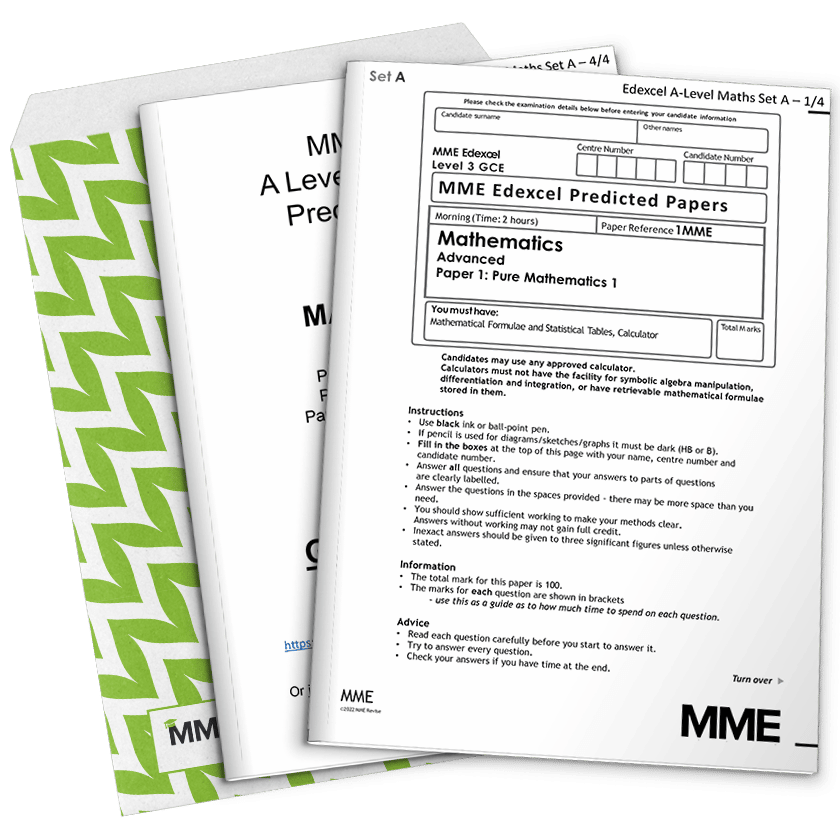Parametric Integrals
Parametric Integrals Revision
Parametric Integrals
When dealing with parametric equations, integrals become more complicated. We cannot just do \int y \, dx when we don’t have y written in terms of x. Instead, we must use the chain rule to get an integral in terms of the parameter. Then, if it is a definite integral, we must convert the limits to fit the new integration.
Make sure you are happy with the following topics before continuing.
The Chain Rule
Recall: The Chain Rule.
\dfrac{dy}{dx}=\dfrac{dy}{dz}\dfrac{dz}{dx}
If we have parametric equations and y isn’t written in terms of x, but instead it is written in terms of t say, then we can use the chain rule to show that dx=\dfrac{dx}{dt} \, dt for a parameter t, and since we have x in terms of t we can get \dfrac{dx}{dt} in terms of t, and we already have y in terms of t, so our integral can be written as:
{\LARGE \int} y \, dx={\LARGE \int} y \, \dfrac{dx}{dt} \, dt
Limit Conversion
If we have a definite integral \int^{b}_{a}y \, dx, then we cannot just take our limits a and b and put them on our new integral in terms of t, because they are limits with respect to x.
Instead, we need to convert them.
This means that the lower limit on the integral in terms of t is the t value that gives x=a, and the upper limit on the integral in terms of t is the t value that gives x=b.
With these converted limits we can find the value of the definite integral.
Example 1: Using the Chain Rule
A parametric equation is x=3t+4 and y=t^{2}. Find \int y \, dx in terms of t.
[2 marks]
\int y \, dx={\LARGE \int} y\dfrac{dx}{dt} \, dtx=3t+4
\dfrac{dx}{dt}=3
y=t^{2}
\int y \, dx=\int 3t^{2} \, dt
\int y \, dx=t^{3}+c
Example 2: Definite Integrals
A parametric curve is defined by y=t^{3}+3t, x=t^{2}+4t+4, for t>-3. Find \int^{4}_{0}y \, dx.
[3 marks]
First convert limits.
x=t^{2}+4t+4First limit: x=0
t^{2}+4t+4=0
(t+2)^{2}=0
t=-2
Second limit: x=4
t^{2}+4t+4=4
t^{2}+4t=0
t(t+4)=0
t=0 or t=-4
t=-4 not in range
t=0
\int^{4}_{0} y \, dx={\LARGE\int}^{0}_{-2} \, y\dfrac{dx}{dt} \, dt
x=t^{2}+4t+4
\dfrac{dx}{dt}=2t+4
y=t^{3}+3t
\begin{aligned}\int^{4}_{0} y \, dx&=\int^{0}_{-2}(t^{3}+3t)(2t+4) \, dt\\[1.2em]&=\int^{0}_{-2}\left( 2t^{4}+4t^{3}+6t^{2}+12t\right) dt\\[1.2em]&=\left[\dfrac{2}{5}t^{5}+t^{4}+2t^{3}+6t^{2}\right]^{0}_{-2}\\[1.2em]&=\left( \dfrac{2}{5}\times0^{5}\right) +0^{4}+\left( 2\times0^{3}\right) +\left( 6\times0^{2}\right)-\left( \dfrac{2}{5}\times(-2)^{5}\right) -(-2)^{4} - 2(- 2)^{3} - 6( -2)^{2} \\[1.2em]&=\left( \dfrac{2}{5}\times32\right) -16+\left( 2\times8\right) -\left( 6\times4\right) \\[1.2em]&=\dfrac{64}{5}-16+16-24\\[1.2em]&=-\dfrac{56}{5}\end{aligned}
Parametric Integrals Example Questions
Question 1: A curve has parametric equation x=t^{2}+2, y=t^{3}+4t^{2}+4t+3. Show that \int y \, dx=\int\left( 2t^{4}+8t^{3}+8t^{2}+6t\right) dt
[2 marks]
\int y \, dx={\LARGE \int} y\dfrac{dx}{dt}dt
x=t^{2}+2
\dfrac{dx}{dt}=2t
y=t^{3}+4t^{2}+4t+3
\begin{aligned}\int y \, dx&=\int\left( 2t(t^{3}+4t^{2}+4t+3)\right) \, dt \\[1.2em]&=\int\left( 2t^{4}+8t^{3}+8t^{2}+6t\right) \, dt \end{aligned}
Question 2: Find \int y \, dx in terms of t, where y=t^{-\frac{1}{2}} and x=4t^{\frac{5}{9}}
[2 marks]
\int y \, dx={\LARGE \int} y\dfrac{dx}{dt}dt
x=4t^{\frac{5}{9}}
\dfrac{dx}{dt}=\dfrac{20}{9}t^{-\frac{4}{9}}
y=t^{-\frac{1}{2}}
\begin{aligned}\int ydx&=\int \left( t^{-\frac{1}{2}}\times\dfrac{20}{9}t^{-\frac{4}{9}}\right) dt\\[1.2em]&=\int \dfrac{20}{9}t^{-\frac{17}{18}}dt\\[1.2em]&=\left( \dfrac{20}{9}\div\dfrac{1}{18}\right) t^{\frac{1}{18}}+c\\[1.2em]&=40t^{\frac{1}{18}}+c\end{aligned}
Question 3: A parametric curve is defined by x=2t+4, y=t+6. Find \int^{6}_{0}y \, dx
[3 marks]
First find the new limits.
Upper limit x=6
2t+4=6
2t=2
t=1
Lower limit x=0
2t+4=0
2t=-4
t=-2
Thus:
\int^{6}_{0}y \, dx={\LARGE \int}^{1}_{-2}y\dfrac{dx}{dt} \, dt
x=2t+4
\dfrac{dx}{dt}=2
y=t+6
\begin{aligned}\int^{6}_{0}y \, dx&=\int^{1}_{-2}2(t+6) \, dt\\[1.2em]&=\int^{1}_{-2}\left( 2t+12\right) \, dt\\[1.2em]&=[t^{2}+12t]^{1}_{-2}\\[1.2em]&=1^{2}+\left( 12\times1\right) -(-2)^{2}-\left( 12\times(-2)\right) \\[1.2em]&=1+12-4+24\\[1.2em]&=33\end{aligned}
You May Also Like...

MME Learning Portal
Online exams, practice questions and revision videos for every GCSE level 9-1 topic! No fees, no trial period, just totally free access to the UK’s best GCSE maths revision platform.






